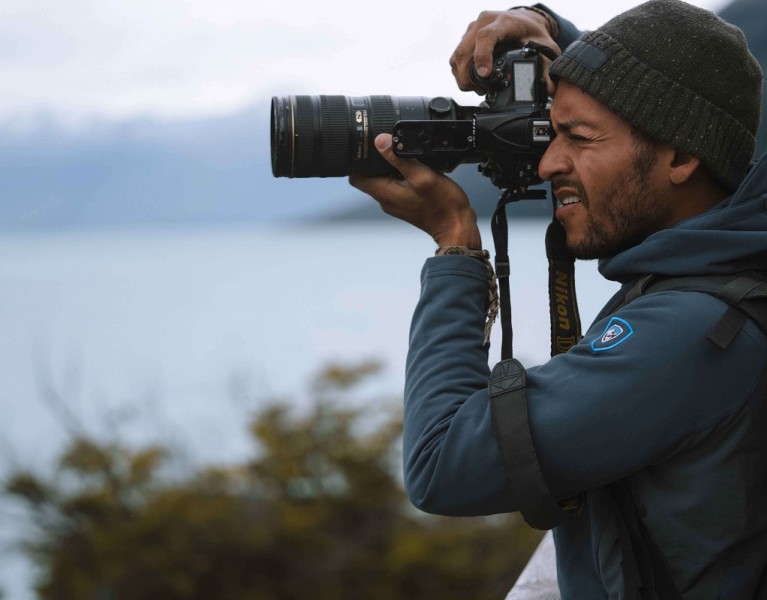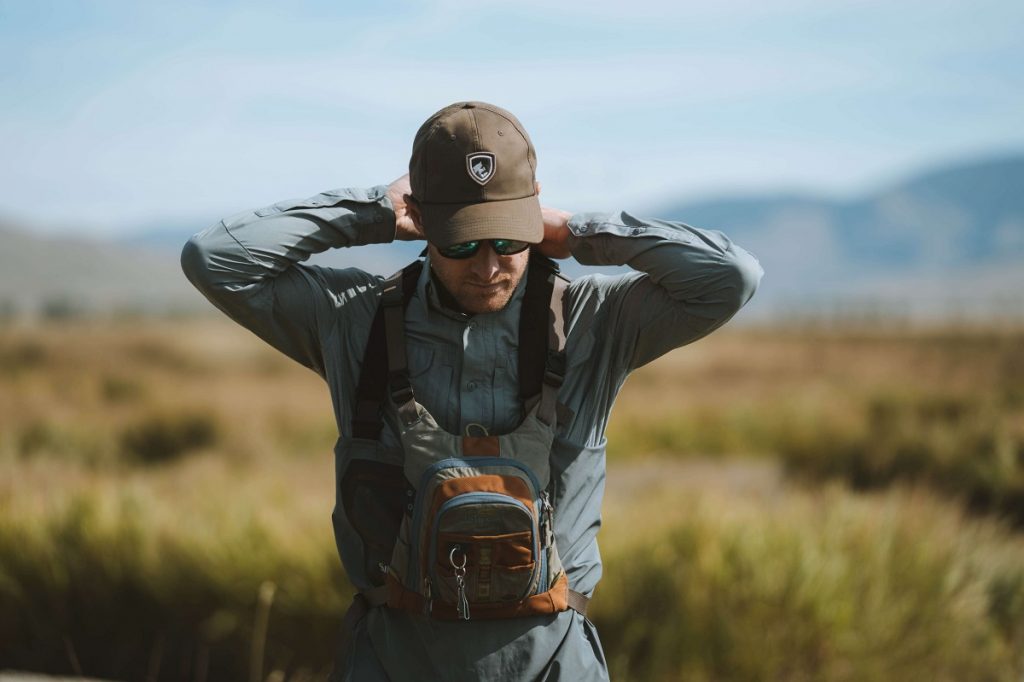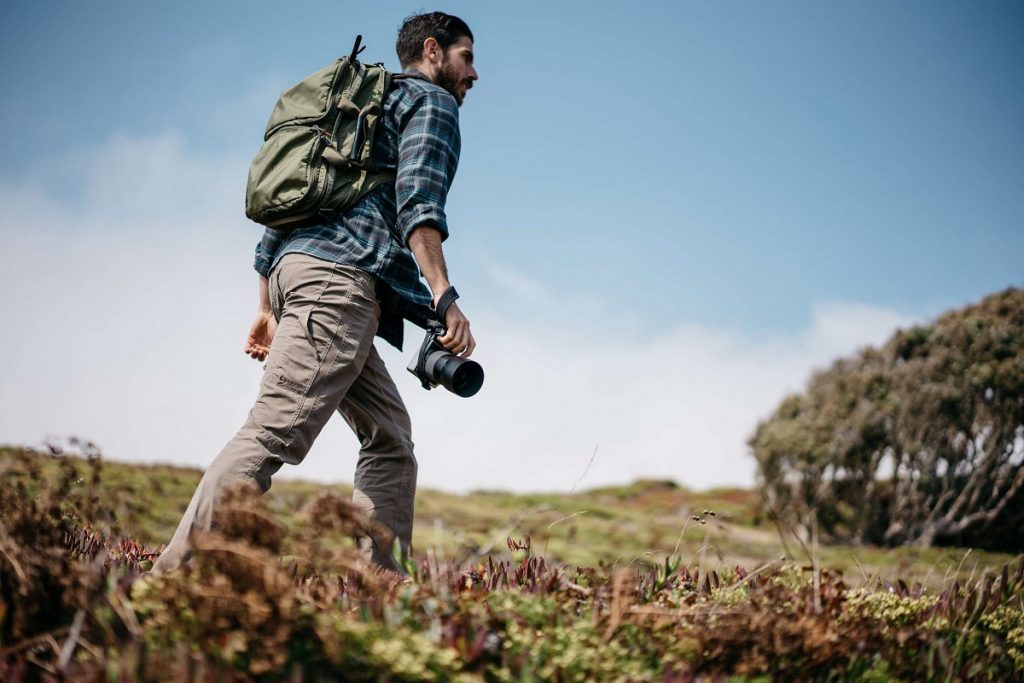- 1. Nature photography clothing: What to look for
- 1.1. Neutral colors
- 1.2. Full range of motion
- 1.3. Lots of pockets
- 1.4. Quiet fabric
- 1.5. Layering, redefined
- 1.6. Visibility when it counts
- 1.7. Sun-safe clothing (breathable shirts with UPF and DWR)
- 2. Gear notes from an outdoor photography veteran
- 2.1. "Chase the light" also means "streamline your sh*t".
- 2.2. Glare is a giveaway
- 2.3. Tone down the noise
- 3. Quality outdoor clothing is important to outdoor photographers

A Guide to Nature Photography Clothing & Personal Gear
Table of Contents [Show]
I've been a North American nature photographer for years. I've stalked musk oxen, arctic fox, and caribou in Nunavut; wolves, and marten in Montana; and migrating birds along the Texas/Mexican border. I've visited other top wildlife photography destinations in South America, Africa, and Australia. Over the decades my photography has improved a hundred-fold, but my biggest achievement? Nailing down my packing manifest.
You can have the best photography equipment and eye for composition in the world, but I staunchly believe you can't become a pro-level nature photographer if you don't have the right clothing and accessories. If you're not comfortable, you'll lose motivation to leave the selfie-obsessed crowds behind and reach the lesser-visited vistas and wildlife hotspots. If you don't make it safely back to your digital studio, nobody's going to know that you got a non-blurry shot of a wolverine, or photographic proof of Sasquatch that doesn't require the notorious "look here" red circle.
Nature and wildlife photographers have to pack for long flights, overland travel, and treacherous terrain. Everything you bring with you has to count, and I learned the hard way how the wrong choices can turn a trip to the tundra into a nightmare slog, resulting in far more photos of reindeer moss and cranberries than I bagged of 'bou.
I'm going to save you the pain and expense. Here's my criteria for nature, landscape, and adventure sports photography clothing, and a few tricks that will lighten your load.
Nature photography clothing: What to look for
Most outdoor photographers picked up their hobby after earning experience on the trails, so I'll skip the basics of layering, durability, and weather-resistance. You already know how important these are for a successful expedition, whether it's an afternoon in a county park or a month-long photo safari on the Serengeti. Here's how to fine-tune your outdoor photography wardrobe.
Neutral colors
You don't have to wear a ghillie suit or dress head-to-toe in camouflage to conceal yourself from shy wildlife species. Earth-toned outdoor clothing and packs work just fine in any season. Black clothes stand out more than you'd think, and some wildlife can see bright colors better than you'd expect.
Black and white starkly contrast with your surroundings, and even if you're in an arctic setting it's best to mimic dormant vegetation or exposed ground rather than snow or even basalt outcroppings.
Full range of motion
You'll be climbing, squatting, kneeling, and shifting position, and (trust me) you don't want your clothing to give you a wedgie or your pants to ride up or chafe. Look for articulated and reinforced knee and elbows, and extra panels in the crotch.
Lots of pockets
Avoid fumbling around in your camera pack for the little things. Stash memory cards, your favorite filters, lens cloths, and batteries in your pockets, and stay consistent with your on-body storage arrangement. Opt for men's convertible pants with side pockets, as you're less likely to crush them when you're sitting.
In case you're wondering, I'm not a huge fan of photography vests. While they're great for fudging airline carry-on restrictions, they're awkward and noisy in the wild. On the other hand, you might want to try a high-quality fly fishing vest if you're not lugging along a ton of lenses and extra camera bodies. Be sure to pad your equipment (I like neoprene drawstring pouches) as you would with any dedicated photo vest and don't bring any lenses bigger than a pan-sized brook trout.
Quiet fabric
From your outer shell down to your snake gaiters, you've got to eliminate what I call the "zook zooks"—the sounds your clothing makes when subjected to friction, wind, and motion. Soft textures make less of a racket, and modern all-weather layers no longer have to sound like cheap plastic tarps.
Layering, redefined
All outdoor enthusiasts know that moisture-wicking, breathable fabrics protect against hypothermia and chafing, but most outdoor adventurers don't spend much time lurking in wet grass or lying still for hours on the cold, hard ground. Water-repelling outer layers year-round, mid-layers that insulate when compressed, and wicking layers that keep you cool and dry as you wait along a game trail under the summer sun as much as they do while you're snowshoeing after Canadian lynx.
I'm a huge fan of the Merino wool base and mid-layers. It's lightweight, keeps you warm when it's wet, and doesn't retain odors the way many fleece materials do.
Visibility when it counts
Neutral-colored clothing and photography gear will prevent flighty wildlife from spotting you, but it's not exactly ideal if you've triggered your rescue beacon or you're out photographing the elk rut at the height of hunting season. I'm partial to safety orange vests used on construction sites and road crews—those with a ton of reflective details—but in a pinch, you can pick up a plain ol' safety vest at most sporting goods stores.
Sun-safe clothing (breathable shirts with UPF and DWR)
It's important to keep up with sunscreen discipline, but you've got another weapon against skin damage. Take advantage of long-sleeved shirts, pants, and neck gaiters made with UV-blocking fabric technology. Choose outfits for summer rated with an ultraviolet protection factor (UPF) of at least 25.
Gear notes from an outdoor photography veteran
I've learned the following from a ton of old-school photographers and backcountry guides, whether I joined them on expeditions or field-tested their advice from nature photography magazines.
"Chase the light" also means "streamline your sh*t".
The outdoor photographer's motto has more than one meaning. Ever hike 15 miles with an overloaded camera pack, only to be so tired and burned out you start to think game farm photography is your new jam? Lighten up with multi-purpose gear and accessories.
- Choose wading and walking staffs with camera attachments. Even if you have a lightweight tripod, a convertible monopod is easier to deploy for those spontaneous shots.
- Ponchos or spare clothing in stuff sacks will stabilize your camera if you're lying prone. A poncho and walking staff can make an impromptu shelter or blind; the latter will help break up your silhouette.
- Hang a full, reusable water bottle (also taped, if it's metallic) from your tripod's center post to add stability by lowering its center of gravity.
- Pick up a pair of hybrid mitten/gloves. These are fingerless with a half-mitten that flips over your fingertips—fantastic for winter photography trips when you need dexterity in a flash, but ultimate warmth during the wait. Most hunting outfitters sell them; I prefer camo for these accessories because I'm convinced they make hand movement less noticeable.
Glare is a giveaway
Shine belongs in your belly when you get back to camp—not on your equipment.
Neutral-colored (or, better yet, camo-patterned) tape wrapped on your tripod legs and center post reduces metallic glare—something to which birds are especially sensitive. It also tones down the silhouette; there are very few straight lines in nature.

Don't forget to swap out those aviator sunglasses for non-reflective frames and lenses. I'd go into my story about how those little bridge pads always get tangled in my hair at the wrong moment, but I'll give you the summary: It involves a lot of bad language, a little pain, and once (and only once) missing the moment: That time when an elk calf stood nose-to-nose with its mom in a field of bright orange hawkweed.
Tone down the noise
Every nature, landscape, and outdoor photographer has their own checklist of lenses, camera bodies, lighting, and accessories. I call mine my "battle rattle," a term I borrowed from my military buddy, but the actual rattle is something you want to avoid. You've already picked up quiet outdoor clothing, but be sure your gear doesn't give you away as you head down the trail.
Except if you're in bear country. If you surprise a bear, you'll have a very bad day.
Replace metal zipper pulls (KÜHL Radikl pants, for example, have a cell-phone pocket without zipper) with ribbon or cord loops; stuff extra space with soft, lightweight padding (here's where extra socks, blankets, and gloves play double-duty); and repack snacks and beverages in crinkle-free containers. Speaking of beverages, if you don't have a bladder-style hydration system (which I highly recommend) always combine partially-full water bottles to eliminate sloshing.
Quality outdoor clothing is important to outdoor photographers
There's a bonus when well-made, durable items hold up over time: You can create an outfit that lets you grab that accessory relying on habit and muscle memory without performing the Maracrena pat-down. Nature photographers have to adapt to spontaneity, but a routine and consistent packing list keep you ready for anything, at any moment. We consider it as much a part of our technique as choosing the right camera settings and composition.
Quality, rugged clothing is why I'm a KÜHL fan, and their dedication to sustainable production and support of open spaces, wildlife, and adventure-based education is more than just a bonus—it makes me happy to know they're contributing to my job security. What's the point of buying adventure clothing that outlasts the beauty of the outdoors?



